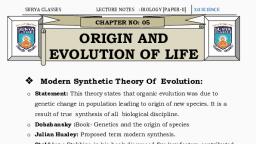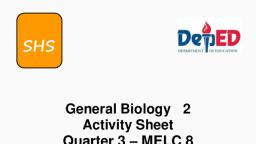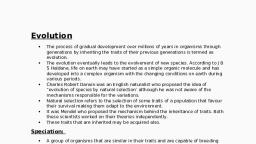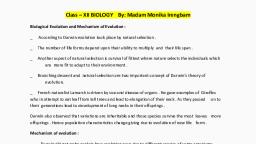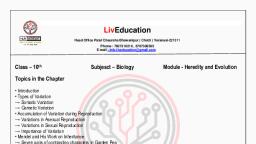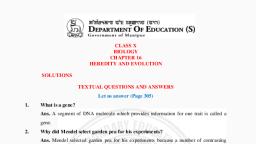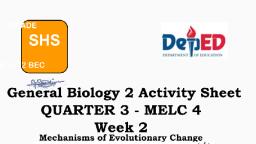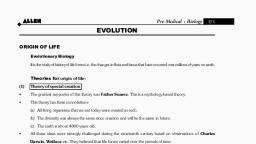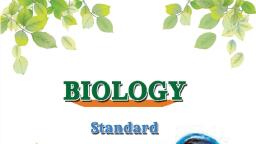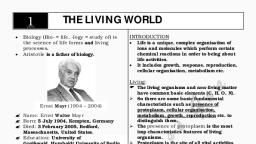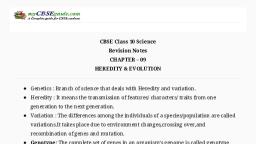Page 1 :
SHS, General Biology 2, Activity Sheet Quarter 3, MELC 6, Development of Evolutionary, Thought, , REGION VI - WESTERN, VISAYAS, i
Page 2 :
General Biology 2, Activity Sheet No. 6 - Development of Evolutionary Thought, First Edition, 2021, Published in the Philippines, By the Department of Education, Region 6 – Western Visayas, Republic Act 8293, section 176 states that: No copyright shall subsist in any work, of the Government of the Philippines. However, prior approval of the government agency or, office wherein the work is created shall be necessary for exploitation of such work for profit., Such agency or office may, among other things, impose as a condition the payment of, royalties., This Learning Activity Sheet is developed by DepEd Region 6 – Western Visayas., ALL RIGHTS RESERVED. No part of this learning resource may be reproduced or, transmitted in any form or by any means electronic or mechanical without written permission, from the DepEd Regional Office 6 – Western Visayas., , Development Team of Activity Sheet, Writers: APRIL JOY A. TALAS, Schools Division Quality Assurance Team:, First Editing:, Dr. MARY CHERRY LYNN M. DALIPE, Content and Language Editing:, Dr. MARY CHERRY LYNN M. DALIPE, Division of Aklan Management Team:, Dr. MIGUEL MAC D. APOSIN, CESOV, Mr. SAMUEL J. MALAYO, Dr. DOBIE P. PAROHINOG, Dr. MARY CHERRY LYNN M. DALIPE, Mr. MAHNNIE Q. TOLENTINO, Regional Management Team, RAMIR B. UYTICO, PEDRO T. ESCOBARTE, JR., ELENA P. GONZAGA, DONALD T. GENINE, ROVEL R. SALCEDO, , MOONYEEN C. RIVERA, ANITA S. GUBALANE, MINDA L. SOLDEVILLA, DAISY L. LOPEZ, JOSEPH M. PAGALARAN, ii
Page 3 :
Introductory Message, Welcome to General Biology 2!, The Learning Activity Sheet is a product of the collaborative efforts of, the Schools Division of Aklan and DepEd Regional Office VI - Western Visayas, through the Curriculum and Learning Management Division (CLMD). This is, developed to guide the learning facilitators (teachers, parents and responsible, adults) in helping the learners meet the standards set by the K to 12 Basic, Education Curriculum., The Learning Activity Sheet is self-directed instructional materials, aimed to guide the learners in accomplishing activities at their own pace and, time using the contextualized resources in the community. This will also, assist the learners in acquiring the lifelong learning skills, knowledge and, attitudes for productivity and employment., , For learning facilitator:, The General Biology 2 Activity Sheet will help you facilitate the leachinglearning activities specified in each Most Essential Learning Competency (MELC), with minimal or no face-to-face encounter between you and learner. This will be, made available to the learners with the references/links to ease the independent, learning., , For the learner:, The General Biology 2 Activity Sheet is developed to help you continue, learning even if you are not in school. This learning material provides you with, meaningful and engaging activities for independent learning. Being an active, learner, carefully read and understand the instructions then perform the activities, and answer the assessments. This will be returned to your facilitator on the agreed, schedule., , iii
Page 4 :
Name of Learner:, Grade and Section:, , Date:, , General Biology 2 ACTIVITY SHEET No. 6, Development of Evolutionary Thought, , I. Learning Competency with Code, Trace the development of evolutionary thought. (STEM_BIO11/12-IIIc-g-11), , II. Background Information for Learners, Evolutionary thought, the recognition that species change over time and the, perceived understanding of how such processes work, is directly traceable to, developments in intellectual thought in western Europe over the last 300 years., Many people contributed to this shift in perspective., The following are early scientist who contributed to shaping and developing, evolutionary thought:, Scientist, Carolus, Linnaeus, (1707-1778), , Jean-Baptiste, Lamarck, (1744-1829), Georges Cuvier, (1769-1832), Thomas Malthus, (1766-1834), , James Hutton, (1726 – 1797), Charles Lyell, (1797-1875), , Contribution/Discovery, Description, Systema Naturae (Systems He developed a method of, of Nature), classifying plants and animals. He, Binomial nomenclature, standardized the use of genus and, species terminology and, established the two-name, classification system., Inheritance of acquired, According to this theory, a trait, characteristics, or the, acquired by an animal during its, use-disuse theory, lifetime can be passed on to, offspring., A belief that the earth’s geological, Catastrophism, features are the results of sudden,, worldwide cataclysmic events., He theorized that continued, An Essay on the Principle, population growth would outgrow, of Population, current resources. The book was, cited by Charles Darwin in, development of the theory of, natural selection., The earth’s geological futures are, Theory of gradualism, formed by slow changes., Uniformitarianism, Geological processes observed in, the present are the same as those, that occurred in the past., , 1
Page 5 :
Charles Darwin, (1809-1882), , Natural Selection, On the Origin of Species, , The process through which, populations of living, organisms adapt and change., , 1. Carolus Linnaeus, The Swedish naturalist Carolus Linnaeus (1707-1778) is best known, for developing a method of classifying plants and animals. In his famous work,, Systema Naturae (Systems of Nature) 1753, he standardized the use of genus and, species terminology and established the system of binomial nomenclature. He also, added two more categories: class and order. Linnaeus’ four-level system became the, basis for taxonomy, the system of classification we continue to use today., Another of Linnaeus’ innovations was to include humans in his, classification of animals, placing them in genus Homo and species sapiens., 2. Jean-Baptiste Lamarck, The first scientist to explain the evolutionary process was a French, naturalist named Jean-Baptiste Lamarck (1744-1829). In 1809, Lamarck suggested, a dynamic relationship between species and the environment such that if the, external environment changed, an animal’s activity patterns would also change to, accommodate the new circumstances. This would result in the increased or, decreased use of certain body parts, and consequently, those body parts would be, modified. Because the alteration would make the animal better suited to its habitat,, the trait would be passed on to its offspring. This theory is known as the inheritance of, acquired characteristics, or the use-disuse theory. Thus, according to this theory, a trait, acquired by an animal during its lifetime can be passed on to offspring. Today we, know that this explanation is wrong, because only those traits that are influenced by, genetic information contained within sex cells can be inherited., Moreover, he coined the term biology to refer to studies of living organisms., 3. Georges Cuvier, Georges Cuvier (1769-1832), the most vehement opponent of Lamarck,, was a French vertebrate paleontologist who introduced the concept of extinction to, explain the disappearance of animals represented by fossils. Rather than assume, that similarities between certain fossil forms and living species indicated evolutionary, relationships, he suggested a variation of theory known as catastrophism. In his, Essay on the Theory of the Earth (1813) Cuvier proposed that now-extinct species, had been wiped out by periodic catastrophic flooding events., Catastrophism was the belief that the earth’s geological features are the, results of sudden, worldwide cataclysmic events like the Noah flood. He suggested, that a series of regional disasters had destroyed most or all the plant and animal life, in various places. These areas were then restocked with new, similar forms that, migrated in from unaffected regions., 4. Thomas Malthus, In 1798, Thomas Malthus (1766-1834), an English clergyman and, economist, wrote An Essay on the Principle of Population , which inspired both, Charles Darwin and Alfred Wallace in their separate discoveries of natural selection., In his essay, Malthus argued for limits to human population growth and pointed out, 2
Page 6 :
that human populations could double in size every 25 years if they weren’t kept in, check by limited food supplies., Darwin accepted Malthus’s proposition that population size increases, exponentially while food supplies remain relatively constant, and they extended it to, all organisms. He recognized the important fact that when population size is limited, by the availability of resources, there must be constant competition for food and, water. And competition between individuals is the ultimate key to understanding, natural selection., 5. James Hutton, Hutton (1726 – 1797) is best known for his theory of gradualism., Hutton was a geologist who left the medical field to travel and study the earth’s, surface. In 1785, Hutton published his paper titled ‘Theory of the Earth.’ In this, paper, he explained how the study of geology confines itself as the study of the, material makeup of the earth. He suggested many explanations and origins for many, geological occurrences ranging from molten rock formations to the origins of, materials found on sea floors., It was not until the third version of the Theory of the Earth was, published when Hutton introduced his theory of gradualism. This is where he, recognized that change did occur, but that change was the gradual culmination of, slow processes happening over great amounts of time. By using this idea, it is, possible to observe the earth today and make assumptions about the past since, change happened over such a long period of time, the earth today must be relevant, to the earth of the past., 6. Charles Lyell, Charles Lyell (1797-1875), the son of Scottish landowners, is, considered the founder of modern geology. In 1833, his immensely important work,, Principles of Geology, he argued the geological processes observed in the present are, the same as those that occurred in the past. This theory is called uniformitarianism., The theory demonstrated that such forces as wind, water erosion, local flooding,, frost, decomposition of vegetation, volcanoes, earthquakes, and glacial movements, had all contributed in the past to produce the geological landscape that exists in the, present. What is more, the fact that these processes still occurred indicated that, geological change was still happening and that the forces driving such change were, consistent, or uniform, over time., 7. Charles Darwin, Charles Darwin (1809-1882) was one of six children of Dr. Robert and, Susanna Darwin. After the death of his mother when he was eight years old, Darwin, was raised by his father and his older sisters. Because he showed little interest in, anything except hunting, shooting, and perhaps science, his father sent him to, Edinburgh University to study medicine. It was there that Darwin first became, acquainted with the evolutionary theories of Lamarck and others., While at Edinburgh, young Darwin studied with professors who were, outspoken supporters of Lamarck. Therefore, although he hated medicine and left, Edinburgh after two years, his experience there was a formative period in his, intellectual development., , 3
Page 7 :
Even though Darwin was indifferent to religion, he next went to Christ’s, College, Cambridge, to study theology. It was during his Cambridge years that he, seriously cultivated his interests in natural science, immersing himself in botany and, geology. It is no wonder that following his graduation in 1831, he was invited to join, a scientific expedition that would circle the globe. And so, it was that Darwin set sail, abroad the HMS Beagle on December 17, 1831 that would take almost five years and, would forever change not only the course of Darwin’s life but also the history of, biological science., Darwin went abroad the Beagle believing in fixity of species. But during the, voyage he privately began to have doubts. During the famous stopover at the, Galapagos Islands, Darwin noticed that the vegetation and animals (especially) birds, shared many similarities with those on the mainland of South America. But they, weren’t identical to them. What’s more, the birds on one island were somewhat, different from those living on another. Darwin collected 13 different varieties of, Galapagos finches, and it was clear that they represented a closely affiliated group;, but they differed regarding certain physical traits, particularly the shape and size of, their beaks., The insight that Darwin gained from the finches is legendary. He recognized, that the various Galapagos finches had all descended from a common mainland, ancestor and had been modified over time in response to different island habitats, and dietary preferences., Darwin arrived back in England in October 1836 and was immediately, accepted into the most prestigious scientific circles. He married his cousin, Emma, Wedgwood, and moved to the village of Down, near London, where he spent the rest, of his life writing on topics ranging from fossils to orchids., At Down, Darwin began to develop his views on what he called natural, selection. This concept was borrowed from animal breeders, who choose, or “select”,, as breeding stock those animals that possess certain traits they want to emphasize, in offspring. Darwin applied his knowledge of domesticated species to naturally, occurring ones, recognizing that in undomesticated organisms, the selective agent is, nature, not humans., By the late 1830s, Darwin had realized that biological variation within a, species was crucial. Furthermore, he recognized that sexual reproduction increased, variation, although he didn’t know why. Then, in 1838, he read Malthus’ Essay, and, there he found the answer to the question of how new species came to be. He, accepted from Malthus that populations increase at a faster rate than do resources,, and he recognized that in nonhuman animals, increase in population size is, continuously and restricted by limited food supplies. He also accepted that in nature, there is a constant “struggle for existence”. The idea that in each generation more, offspring are born than to survive to adulthood, coupled with the notions of, competition for resources and biological diversity, was all Darwin needed to develop, his theory of natural selection., In December 1859, Darwin completed and published his greatest work, On, the Origin of Species, where the riddle of species was now explained: Species were, mutable, not fixed; and they evolved from other species through the mechanism of, natural selection., , 4
Page 8 :
III. Activity Proper, Direction: Development of Evolutionary Thought Timeline. Trace the development of, evolutionary thought by completing the timeline below. Fill in the boxes with the, time (year), the scientists and their significant contributions towards the, development of evolutionary thought., , IV. Reflection, Complete the statements below., I understand, , I don’t understand, , I need more information about, , 5
Page 9 :
V. Links and Other References, Penecilla, G. L., Valmonte, L. D., Fandialan, M. M., Formacion, M. J.,, Sandoval, A. M., and Esmeralda, N. P. (2003). Basic concepts in, biology. Bulacan: Trinitas Publishing, Inc., Freeman, S. Biological Science . 3rd ed. 2008. California: Pearson Benjamin, Cummings. pp. 503-525., Reece, JB, LA Urry, ML Cain, S Wasserman, PV Minorsky, RB Jackson., Campbell Biology . 9th ed. 2014. Illinois: Pearson Education Inc. pp., 462-470., Russell PJ, SL Wolfe, PE Hertz, C Starr, B Mc Millan. Biology: The Dynamic, Science. 2008. California: Brooks/Cole CENGAGE Learning. pp., 401-418., Commission on Higher Education in collaboration with Philippine Normal, University. (2016). General Biology 2: Teaching Guide for Senior, High School. Quezon City: CHED, Hereditary and Evolution: Chapter 2. 2021. Retrieved from, http://rcastilho.pt/EVO/ewExternalFiles/Lewis_Cap2.pdf, Development of Evolutionary Thought. 2021. Retrieved from, https://sci.waikato.ac.nz/evolution/DevelopmentEvolThought.shtml, , 6
























